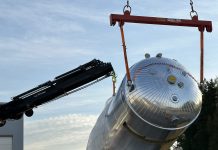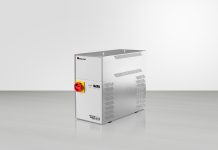Ultrashort pulse lasers can serve to apply functional microstructures and nanostructures to any surface. This type of laser machining is usually done by just one beam from a single source, a far too time-consuming and thus expensive approach to applying the micro- and nanostructures to the large embossing rollers that imprint textures and patterns on fabrics, leather and cardboard. This is why the practice of etching such structures into embossing rollers has prevailed. This is hardly ideal from the environmental perspective, but there was no economically viable alternative – until now, that is.
Anything but corrosive
 A special sort of teamwork has turned laser structuring into a sound business proposition. Instead of a lone ultrashort-pulsed laser beam roaming the surface, the laser energy is split into many laser beams of equal power – specifically, into 200 partial beams. A special optical system serves to control these beams individually and modulate their power. This has created a new digitally-driven tool. With so many of these tools working the surface simultaneously, this process is manyfold faster than conventional laser machining. It is the first affordable option for machining large components. Developed in a joint project called MultiSurf, this technology owes its existence to Dr. Arnold Gillner, Martin Reininghaus and Dr. Johannes Finger from the Fraunhofer Institute for Laser Technology ILT, Dr. Stephan Brüning from Schepers GmbH & Co. KG, Dr. Gerald Jenke from Matthews International GmbH, Dr. Keming Du from EdgeWave GmbH Innovative Laser Solutions, and Dr. Manfred Jarczynski from LIMO GmbH. They have been singled out to receive the Science Prize from the Stifterverband für Verbundforschung for their efforts. “We’re practicing something akin to the art of tool cloning here,” says Gillner, head of department at Fraunhofer ILT. “This marks a paradigm shift in manufacturing given that it was always just one tool that was used in the past.” What sounds simple in words is very complicated in the real world. It takes a sophisticated beam guidance system to split the laser beam without losing energy or compromising beam quality. The researchers developed a capable laser and the required optics to this end, and adapted the technology on the process side. With simulations providing insight, they were able to get a better picture of the process.
A special sort of teamwork has turned laser structuring into a sound business proposition. Instead of a lone ultrashort-pulsed laser beam roaming the surface, the laser energy is split into many laser beams of equal power – specifically, into 200 partial beams. A special optical system serves to control these beams individually and modulate their power. This has created a new digitally-driven tool. With so many of these tools working the surface simultaneously, this process is manyfold faster than conventional laser machining. It is the first affordable option for machining large components. Developed in a joint project called MultiSurf, this technology owes its existence to Dr. Arnold Gillner, Martin Reininghaus and Dr. Johannes Finger from the Fraunhofer Institute for Laser Technology ILT, Dr. Stephan Brüning from Schepers GmbH & Co. KG, Dr. Gerald Jenke from Matthews International GmbH, Dr. Keming Du from EdgeWave GmbH Innovative Laser Solutions, and Dr. Manfred Jarczynski from LIMO GmbH. They have been singled out to receive the Science Prize from the Stifterverband für Verbundforschung for their efforts. “We’re practicing something akin to the art of tool cloning here,” says Gillner, head of department at Fraunhofer ILT. “This marks a paradigm shift in manufacturing given that it was always just one tool that was used in the past.” What sounds simple in words is very complicated in the real world. It takes a sophisticated beam guidance system to split the laser beam without losing energy or compromising beam quality. The researchers developed a capable laser and the required optics to this end, and adapted the technology on the process side. With simulations providing insight, they were able to get a better picture of the process.
Teamwork at the human level too
The exemplary collaboration in this project extends beyond the teamwork of the laser beams. Schepers and LIMO are already working on an eight-beam laser structuring system, with Matthews International GmbH using the new laser process to produce press cylinders. This cooperation was another of the project’s merits that swayed the jury. The jury also felt it important that the consortium accurately mirrors and is a perfect fit for the value chain, and that medium-sized enterprises can afford to adopt this approach.



